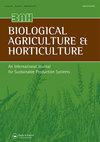Controlled experiment to determine nitrogen availability for seven organic fertilisers in three contrasting soils
IF 1.6
4区 农林科学
Q3 AGRONOMY
引用次数: 1
Abstract
ABSTRACT Organic production systems have generated new technology and management tools, including the use of different nutrient sources. To support to the selection of appropriate organic N fertilisers, based on their N availability over time, a controlled experiment was carried out in three soils with contrasting physical-chemical properties. Seven organic fertilisers, a control without fertiliser and a reference with a conventional fertiliser were used, all providing a total N dose of 100 mg kg−1 soil. Soils were incubated under aerobic conditions for 7, 14, 28, 56 and 112 days, to determine the availability of ammonium, nitrate, and available N. This enabled classification of the fertilisers, according to N availability rates for the total incubation period, as fertilisers with low (compost), medium (Fertil, lupin meal and blood meal), or high (sodium nitrate, Purely Grow and Purely Lysine) N availability rates. According to the speed of N delivery, fertilisers were classified as having a rapid (Purely Grow and sodium nitrate), intermediate (Purely Lysine, blood meal and Fertil), or slow (lupin meal and compost) N delivery speed. The results can be used to support decision making in organic production by enabling the selection of N fertilisers according to their N availability rate and to adjust fertiliser applications to the requirements of the crop.在三种对比土壤中测定七种有机肥料氮有效性的对照试验
摘要有机生产系统产生了新的技术和管理工具,包括使用不同的营养源。为了支持根据氮随时间的可用性选择合适的有机氮肥,在三种物理化学性质不同的土壤中进行了对照实验。使用了七种有机肥料、一种不施肥的对照和一种使用传统肥料的参考,所有这些都提供了100 mg kg−1土壤的总氮剂量。土壤在有氧条件下培养7、14、28、56和112天,以确定铵、硝酸盐和有效氮的可用性。这使得能够根据整个培养期的氮可用率将肥料分类为低(堆肥)、中(肥料、羽扇豆粉和血粉),或高(硝酸钠、纯生长和纯赖氨酸)N可用率。根据氮的输送速度,肥料被分为快速(纯生长和硝酸钠)、中等(纯赖氨酸、血粉和Fertil)或慢速(羽扇豆粉和堆肥)氮输送速度。研究结果可用于支持有机生产的决策,根据氮肥的可用率选择氮肥,并根据作物的要求调整化肥施用。
本文章由计算机程序翻译,如有差异,请以英文原文为准。
求助全文
约1分钟内获得全文
求助全文
来源期刊
CiteScore
3.30
自引率
6.70%
发文量
18
审稿时长
>36 weeks
期刊介绍:
Biological Agriculture & Horticulture aims to act as the central focus for a wide range of studies into alternative systems of husbandry, and particularly the biological or organic approach to food production. The Journal publishes work of a sound scientific or economic nature related to any aspect of biological husbandry in agriculture, horticulture and forestry in both temperate and tropical conditions, including energy and water utilization, and environmental impact.

 求助内容:
求助内容: 应助结果提醒方式:
应助结果提醒方式:


